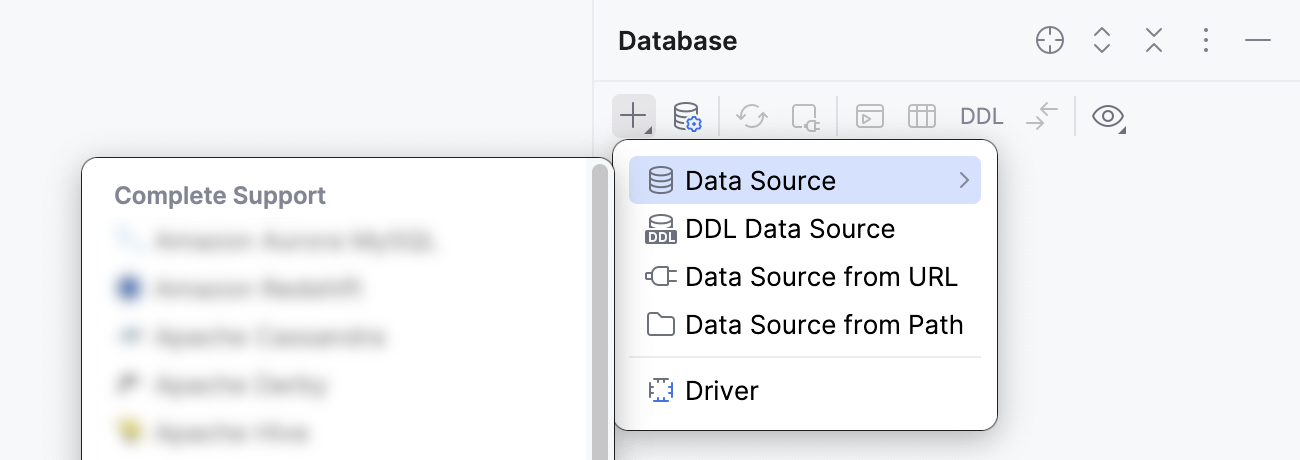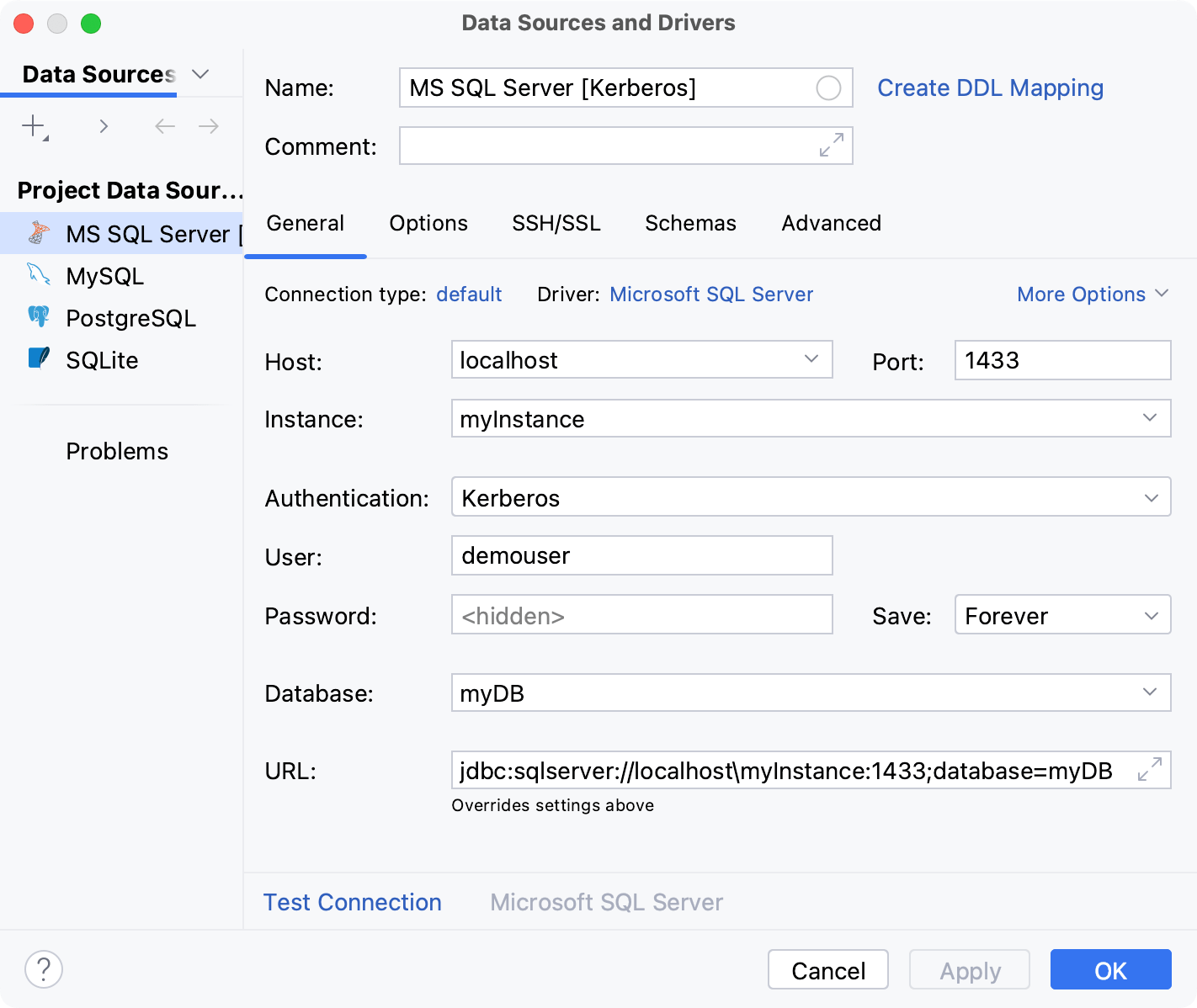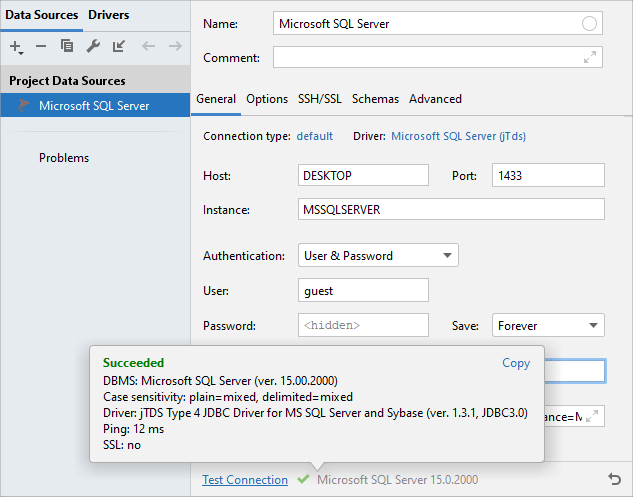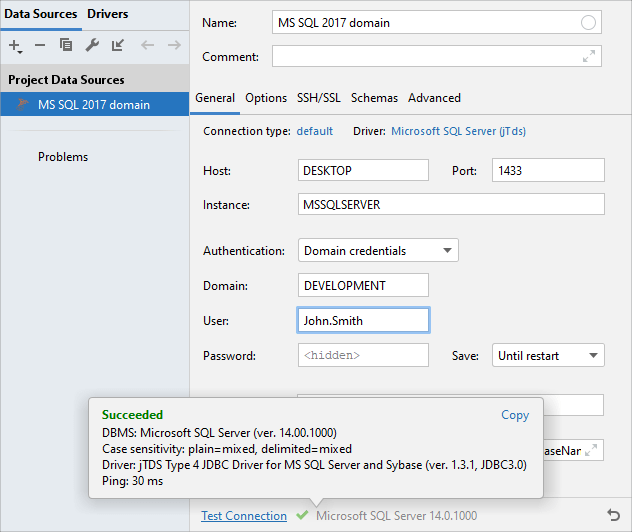Create Microsoft SQL Server data sources with Kerberos and in different OSs
Enable the Database Tools and SQL plugin
This functionality relies on the Database Tools and SQL plugin, which is bundled and enabled in IntelliJ IDEA by default. If the relevant features are not available, make sure that you did not disable the plugin.
Press Ctrl+Alt+S to open settings and then select .
Open the Installed tab, find the Database Tools and SQL plugin, and select the checkbox next to the plugin name.
Official documentation and software
For full information about Microsoft SQL Server, refer to the official documentation.
To download Microsoft SQL Server database software, refer to the official software downloads.
This topic gives you examples of how you can create a data source for Microsoft SQL Server from IntelliJ IDEA. It describes the configuration of IntelliJ IDEA on Windows, macOS, and Linux.
Note that the Use Windows domain authentication checkbox is available only on Windows. To configure Windows domain authentication on macOS and Linux, refer to Connect by using Windows domain authentication.
Required settings
Microsoft SQL Server accepts TCP/IP connections on a dedicated port. By default, it is port 1433 and it is closed by the Microsoft Windows Firewall. When connecting via port, make sure that the Firewall does not close the port that you use.
If the SQL Server Browser is turned on, TCP/IP connection can also be established using the Microsoft SQL Server instance name.
Enable and configure the TCP/IP connection
Follow the official instructions to enable the protocol, check and assign a port number. Verify that other running applications do not use the same port.
Name of the Microsoft SQL Server instance is MSSQLSERVER. By default, the port is
1433.
Connect by using Kerberos
Before establishing connection to a Microsoft SQL Server database with Kerberos authentication, make sure you have the authentication ticket by running Kerberos commands in the command prompt or in the terminal.
If there is a ticket cache file on your machine and
useTicketCacheis set totrue, runklistcommand. Make sure it lists your ticket among the cached ones.If ticket cache is not enabled on your machine, do the following:
Run
klistcommand and make sure it lists your ticket.If your authentication ticket is not on the list, run the
kinitcommand with your username to obtain the ticket from server:kinit sqlsrvkrb. Instead ofsqlsrvkrb, use your username. When prompted, enter your password.
For more information about Kerberos tickets, refer to the Kerberos website.
Create a data source
To connect to a database, create a data source that will store your connection details.
Select the data source you want to create. You can do this using one of the following ways:
In the main menu, go to and select Microsoft SQL Server.
In the Database tool window, click
New on the toolbar. Navigate to Data Source and select Microsoft SQL Server.

Click the Driver link and select the driver for your connection.
Check if there is a Download missing driver files link at the bottom of the connection settings area. Click this link to download drivers that are required to interact with a database. For a direct download link, refer to the JetBrains JDBC drivers page.

Location for the downloaded JDBC drivers is the IntelliJ IDEA configuration directory.
You can also use your drivers for the database instead of the provided ones. For more information about connecting to a database with your driver, refer to Add a user driver to an existing connection.
If there is no Download missing driver files link, then you already have the required drivers.
Specify the database connection details. Alternatively, paste the JDBC URL in the URL field.
In Host, Instance, and Port fields, specify your connection details.
From the Authentication list, select Kerberos.
In the User and Password fields, type your user credentials.
To use no password, leave the Password field empty.
To delete a once entered password, right-click the Password field and select Set Empty.

In the Database field, type the database name to which you want to connect.
Ensure that the database connection can be established using the provided details. To do this, click the Test Connection link at the bottom of the connection details section.

If you encounter any connection issues, refer to the Cannot connect to a database page.
(Optional) By default, only the default database and schema are introspected and available to work with. If you also want to work with other databases and schemas, in the Schemas tab, select them for the introspection.

Click OK to create the data source.
Find your new data source in the Database tool window.
For more information about the Database tool window, see the corresponding reference topic.
For more information about working with database objects in IntelliJ IDEA, refer to Database objects.
To write and run queries, open the default query console by clicking the data source and pressing F4.
To view and edit data of a database object, open Data editor and viewer by double-clicking the object.

Windows
Connect by using SQL Server authentication
In the Database tool window (), click the Data Source Properties icon
. Alternatively, press Ctrl+Alt+Shift+S.
In the Data Sources and Drivers dialog, click the Add icon (
) and select Microsoft SQL Server.
Click the Driver link and select Microsoft SQL Server (jTds).
Check if there is a Download missing driver files link at the bottom of the connection settings area. Click this link to download drivers that are required to interact with a database. For a direct download link, refer to the JetBrains JDBC drivers page.

Location for the downloaded JDBC drivers is the IntelliJ IDEA configuration directory.
You can also use your drivers for the database instead of the provided ones. For more information about connecting to a database with your driver, refer to Add a user driver to an existing connection.
If there is no Download missing driver files link, then you already have the required drivers.
In Host, Instance, and Port fields, specify your connection details. If the server name (for example,
DESKTOP) does not work, replace it with the server IP address.From the Authentication list, select User & Password.
In User and Password fields, specify your credentials.
Ensure that the database connection can be established using the provided details. To do this, click the Test Connection link at the bottom of the connection details section.

If you encounter any connection issues, refer to the Cannot connect to a database page.
(Optional) By default, only the default database and schema are introspected and available to work with. If you also want to work with other databases and schemas, in the Schemas tab, select them for the introspection.

Click OK to create the data source.
Find your new data source in the Database tool window.
For more information about the Database tool window, see the corresponding reference topic.
For more information about working with database objects in IntelliJ IDEA, refer to Database objects.
To write and run queries, open the default query console by clicking the data source and pressing F4.
To view and edit data of a database object, open Data editor and viewer by double-clicking the object.

Connect by using single sign-on for Microsoft SQL Server
If you run IntelliJ IDEA on Windows in the same domain as the Microsoft SQL Server database, you can use the Single-Sign On (SSO).
In the Database tool window (), click the Data Source Properties icon
. Alternatively, press Ctrl+Alt+Shift+S.
In the Data Sources and Drivers dialog, click the Add icon (
) and select Microsoft SQL Server.
Click the Driver link and select Microsoft SQL Server (jTds).
Check if there is a Download missing driver files link at the bottom of the connection settings area. Click this link to download drivers that are required to interact with a database. For a direct download link, refer to the JetBrains JDBC drivers page.

Location for the downloaded JDBC drivers is the IntelliJ IDEA configuration directory.
You can also use your drivers for the database instead of the provided ones. For more information about connecting to a database with your driver, refer to Add a user driver to an existing connection.
If there is no Download missing driver files link, then you already have the required drivers.
In Host, Instance, and Port fields, specify your connection details. If the server name (for example,
DESKTOP) does not work, replace it with the server IP address.From the Authentication list, select Windows credentials (Windows only option).
Ensure that the database connection can be established using the provided details. To do this, click the Test Connection link at the bottom of the connection details section.

If you encounter any connection issues, refer to the Cannot connect to a database page.
(Optional) By default, only the default database and schema are introspected and available to work with. If you also want to work with other databases and schemas, in the Schemas tab, select them for the introspection.

Click OK to create the data source.
Find your new data source in the Database tool window.
For more information about the Database tool window, see the corresponding reference topic.
For more information about working with database objects in IntelliJ IDEA, refer to Database objects.
To write and run queries, open the default query console by clicking the data source and pressing F4.
To view and edit data of a database object, open Data editor and viewer by double-clicking the object.

Connect by using Windows domain authentication
In the Database tool window (), click the Data Source Properties icon
. Alternatively, press Ctrl+Alt+Shift+S.
In the Data Sources and Drivers dialog, click the Add icon (
) and select Microsoft SQL Server.
Click the Driver link and select Microsoft SQL Server (jTds).
Check if there is a Download missing driver files link at the bottom of the connection settings area. Click this link to download drivers that are required to interact with a database. For a direct download link, refer to the JetBrains JDBC drivers page.

Location for the downloaded JDBC drivers is the IntelliJ IDEA configuration directory.
You can also use your drivers for the database instead of the provided ones. For more information about connecting to a database with your driver, refer to Add a user driver to an existing connection.
If there is no Download missing driver files link, then you already have the required drivers.
In Host, Instance, and Port fields, specify your connection details. If the server name (for example,
DESKTOP) does not work, replace it with the server IP address.From the Authentication list, select Domain credentials.
In the Domain field, specify the domain (for example,
DEVELOPMENT).In User and Password fields, specify your domain credentials. In the User field, type your domain user without the domain prefix (for example,
John.Smithinstead ofDOMAIN\John.Smith).Alternatively, on the General tab, specify the connection string. Consider the following example of a full connection string:
jdbc:jtds:sqlserver://DESKTOP:1433;domain=DEVELOPMENT;instance=MSSQLSERVER;databaseName=guest;Ensure that the database connection can be established using the provided details. To do this, click the Test Connection link at the bottom of the connection details section.

If you encounter any connection issues, refer to the Cannot connect to a database page.
(Optional) By default, only the default database and schema are introspected and available to work with. If you also want to work with other databases and schemas, in the Schemas tab, select them for the introspection.

Click OK to create the data source.
Find your new data source in the Database tool window.
For more information about the Database tool window, see the corresponding reference topic.
For more information about working with database objects in IntelliJ IDEA, refer to Database objects.
To write and run queries, open the default query console by clicking the data source and pressing F4.
To view and edit data of a database object, open Data editor and viewer by double-clicking the object.

macOS and Linux
Connect by using SQL Server authentication
In the Database tool window (), click the Data Source Properties icon
. Alternatively, press ⌘ ;.
In the Data Sources and Drivers dialog, click the Add icon (
) and select Microsoft SQL Server.
Click the Driver link and select Microsoft SQL Server (jTds).
Check if there is a Download missing driver files link at the bottom of the connection settings area. Click this link to download drivers that are required to interact with a database. For a direct download link, refer to the JetBrains JDBC drivers page.

Location for the downloaded JDBC drivers is the IntelliJ IDEA configuration directory.
You can also use your drivers for the database instead of the provided ones. For more information about connecting to a database with your driver, refer to Add a user driver to an existing connection.
If there is no Download missing driver files link, then you already have the required drivers.
In Host, Instance, and Port fields, specify your connection details. If the server name (for example,
DESKTOP) does not work, replace it with the server IP address.From the Authentication list, select User & Password.
In User and Password fields, specify your credentials.
Ensure that the database connection can be established using the provided details. To do this, click the Test Connection link at the bottom of the connection details section.

If you encounter any connection issues, refer to the Cannot connect to a database page.
(Optional) By default, only the default database and schema are project and dataset are database is schema is keyspace is namespace is introspected and available to work with. If you also want to work with other databases and schemas projects and datasets databases, schemas, and shared databases databases schemas keyspaces namespaces, in the Schemas tab, select them for the introspection.

Click OK to create the data source.
Find your new data source in the Database tool window.
For more information about the Database tool window, see the corresponding reference topic.
For more information about working with database objects in IntelliJ IDEA, refer to Database objects.
To write and run queries, open the default query console by clicking the data source and pressing F4.
To view and edit data of a database object, open Data editor and viewer by double-clicking the object.

Connect by using Windows domain authentication
In the Database tool window (), click the Data Source Properties icon
. Alternatively, press ⌘ ;.
In the Data Sources and Drivers dialog, click the Add icon (
) and select Microsoft SQL Server.
Click the Driver link and select Microsoft SQL Server (jTds).
Check if there is a Download missing driver files link at the bottom of the connection settings area. Click this link to download drivers that are required to interact with a database. For a direct download link, refer to the JetBrains JDBC drivers page.

Location for the downloaded JDBC drivers is the IntelliJ IDEA configuration directory.
You can also use your drivers for the database instead of the provided ones. For more information about connecting to a database with your driver, refer to Add a user driver to an existing connection.
If there is no Download missing driver files link, then you already have the required drivers.
In Host, Instance, and Port fields, specify your connection details. If the server name (for example,
DESKTOP) does not work, replace it with the server IP address.From the Authentication list, select Domain credentials.
In the Domain field, specify the domain (for example,
DEVELOPMENT).In User and Password fields, specify your domain credentials. In the User field, type your domain user without the domain prefix (for example,
John.Smithinstead ofDOMAIN\John.Smith).Alternatively, on the General tab, specify the connection string. Consider the following example of a full connection string:
jdbc:jtds:sqlserver://DESKTOP:1433;domain=DEVELOPMENT;instance=MSSQLSERVER;databaseName=guest;Ensure that the database connection can be established using the provided details. To do this, click the Test Connection link at the bottom of the connection details section.

If you encounter any connection issues, refer to the Cannot connect to a database page.
(Optional) By default, only the default database and schema are project and dataset are database is schema is keyspace is namespace is introspected and available to work with. If you also want to work with other databases and schemas projects and datasets databases, schemas, and shared databases databases schemas keyspaces namespaces, in the Schemas tab, select them for the introspection.

Click OK to create the data source.
Find your new data source in the Database tool window.
For more information about the Database tool window, see the corresponding reference topic.
For more information about working with database objects in IntelliJ IDEA, refer to Database objects.
To write and run queries, open the default query console by clicking the data source and pressing F4.
To view and edit data of a database object, open Data editor and viewer by double-clicking the object.
